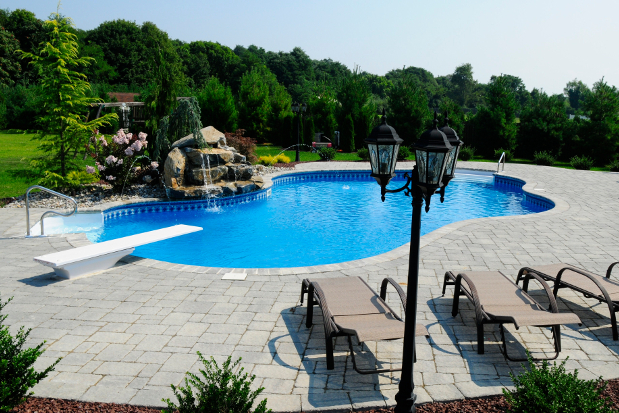
A vinyl pool liner is a multi-purpose pool investment. A good liner improves the appearance of your pool, makes its surface more comfortable for users, and helps to protect your pool and prevent leaks, increasing its life. Since your pool liner is such an integral part, it pays to make sure you purchase a quality product and shell out the cash to have it installed according to specs.
Purchasing a Vinyl Pool Liner
There are three popular types of in-ground pools on the market. Gunite pools have a concrete and plaster “lining” that serves as a water barrier and surface material, fiberglass pools are made from a pre-cast fiberglass shell, and vinyl lined pools are concrete reinforced pools that are covered with a vinyl lining. Vinyl lined pools are by far the most popular, though they do have one downside: liners eventually wear out. You can patch tears and rips as they happen, but there will come a time when your liner simply wears out and you’ll need to purchase a replacement. The cost of pool liner installation or repair can vary depending on the type of liner you choose.
Vinyl Pool Liner Thickness
There are several factors that you should consider when shopping around for a new pool liner, starting with the thickness of the material. Generally thicker liners, in the 25—30 mil range, are better since they resist tears and rips more effectively. As you shop around you’ll notice that liners are measured in both mils and gauges. Unfortunately, both measurements can be misleading, so it’s important that you ask for the precise measurements, in mils, of both the floor and walls of the liner before you make your purchase.
Ready to start your Pool Liner Replacement?
Find ProsAppearance is Important, Too
While the thickness of your new pool liner is the most important factor to consider when making a purchase, the appearance isn’t too far behind. Since your it covers the entire inside surface of your pool, you’ll be shopping for looks as much as performance. Luckily for today’s homeowners, modern vinyl liners come in more designs and colors than you can shake a stick at. In fact, you shouldn’t have any trouble finding a design that suits your fancy.
Vinyl Pool Liner Installation
Many companies advertise their replacement vinyl liners as something a do-it-yourselfer can install without professional assistance. Beware of such claims, however. To some extent it’s true, since any job is doable if you’ve got enough patience, time, and the right tools. That being said, pool liner installation is tricky business. It requires removal of the previous liner, patching up and evening out the concrete subfloor of your pool, and proper installation of the liner itself. If you don’t get it installed just right, you’re almost sure to end up with wrinkles, imperfections, and even rips and tears in your new purchase. With those kinds of risks involved, you’re usually better off hiring someone who knows what they’re doing to do the job right.
Vinyl Pool Liner Maintenance
Once your vinyl pool liner has been installed, there are a few maintenance procedures you should be sure to follow. First and foremost, keep an eye out for rips and tears in the vinyl. As mentioned before, they can, and should, be repaired as soon as possible. Leaks can lead to disastrous consequences as the water penetrates the soil behind and beneath your pool, causing it to shift and settle in the process. From a pool standpoint, that settling can lead to cracks, fissures, and even sinkholes. The other important thing to remember with a vinyl pool liner is that you should never let the water out. The water is what holds your liner in place. Let it out and, at the very least, you’ll need to rent a special vacuum to pull the liner back in place before you fill the pool up again. Worst-case scenario: you’ll have to hire a pool contractor to make the trip out to your home to get you up and running again.
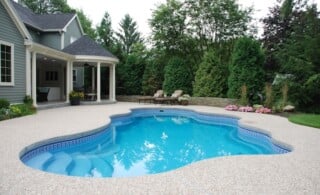 Pros, Cons & Costs: Fiberglass Pools
Pros, Cons & Costs: Fiberglass Pools 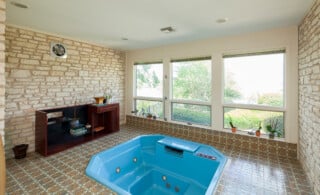 Indoor Hot Tub: A Steamy Situation
Indoor Hot Tub: A Steamy Situation 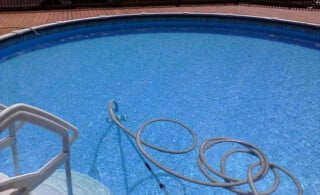 Why Everybody Should Have a Pool Cleaner
Why Everybody Should Have a Pool Cleaner  Quick Tips for a Summer-Ready Pool
Quick Tips for a Summer-Ready Pool 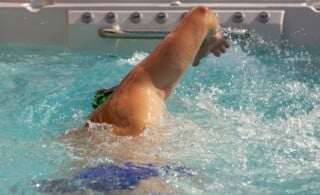 Get in Shape with an Endless Pool
Get in Shape with an Endless Pool 

Are You Familiar With This Topic? Share Your Experience.